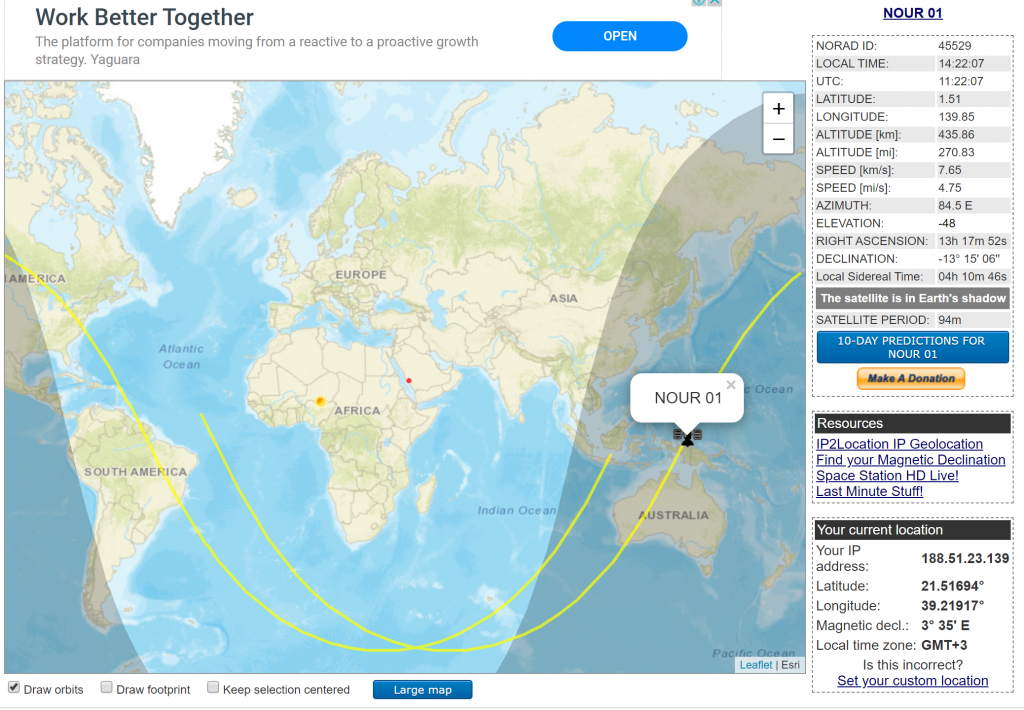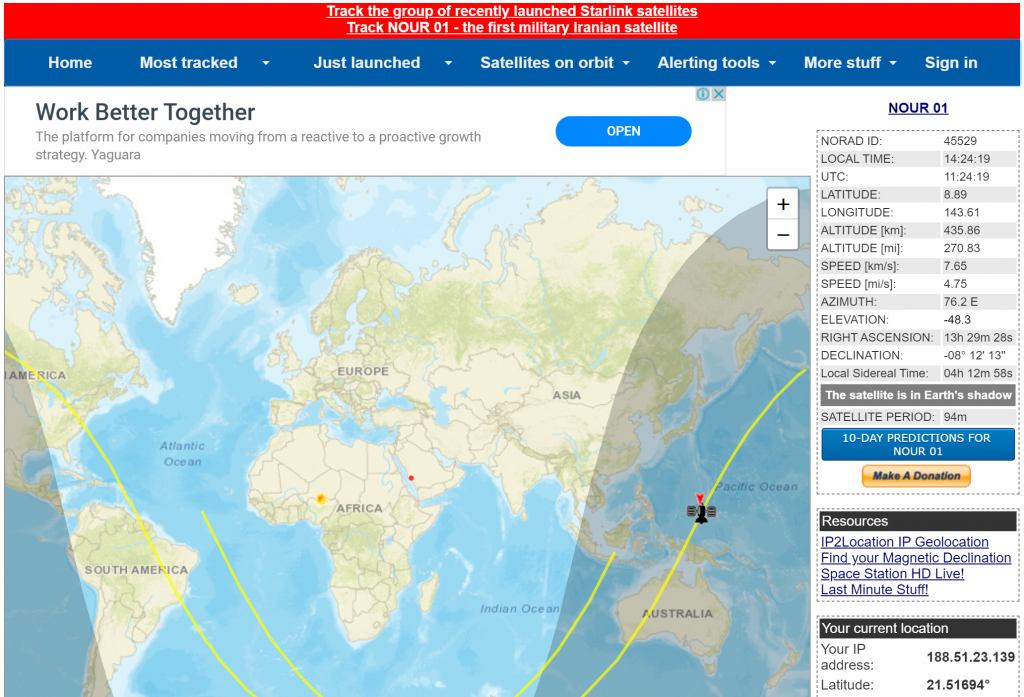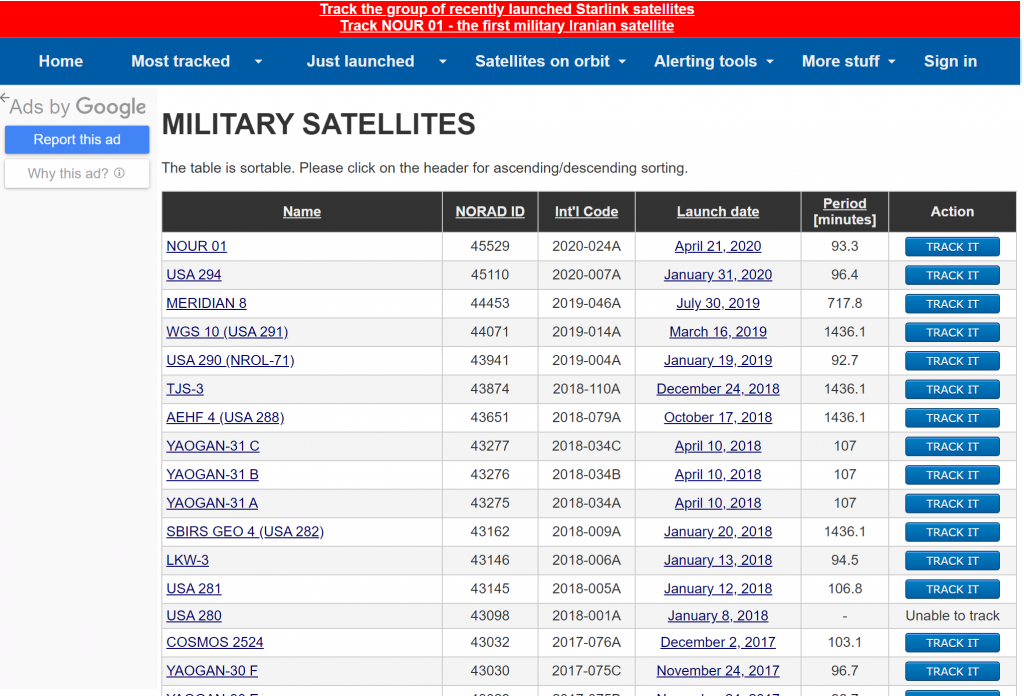On Wednesday (April 22, 2020), Iran announced that it successfully launched a military satellite called “Noor,” or “Light,” into orbit and said the satellite is in orbit 425 kilometers above the earth’s surface. This Iranian move was intended to send an underlying message to the Iranian public domestically and the international community, particularly the United States.
Relations between Washington and Tehran have been strained in the aftermath of the May 2018 US decision to withdraw from the 2015 Iranian nuclear deal — known officially as the Joint Comprehensive Plan of Action (JCPOA) — and reimpose the highest level of economic sanctions against Iran over its nuclear and missile programs. US President Donald Trump pulled out of the Iran nuclear deal as he said the “defective” deal would not stop Iran from developing a nuclear bomb and did not address the country’s ballistic missile program and involvement in the region. The US withdrawal from the Iranian nuclear agreement and the subsequent re-imposition of unilateral sanctions have taken a serious toll on Iran’s economy, causing the rial to depreciate against the dollar, thus affecting the everyday lives of ordinary Iranians.
The Noor Satellite
“Iran’s first military satellite, Noor, was launched this morning from the central desert of Iran. The launch was successful, and the satellite reached orbit,” Iran’s state television said. Iran’s Revolutionary Guard Corps (IRGC) said on its official website that the satellite “Noor” was orbiting 425 km above the earth’s surface. The IRGC also said it used a three-stage rocket called “Qased,” or “Messenger,” satellite carrier to launch the satellite without giving details of the technology. According to the IRGC, the Qased rocket used a mix of liquid and solid fuel.
An image of the rocket that carried the satellite released by Iranian state television showed that it bore a Quranic verse which is typically recited before starting a journey.
The IRGC Aerospace Commander Amir-Ali Hajizadeh said, “The Americans are angry, so it shows the importance of this project,” adding that the satellite launch had “caught western intelligence agencies by surprise.” “We knew that the enemies were after monitoring this task, and we tried to advance it in secret,” Hajizadeh said.
He noted that Iran’s capabilities had successfully deterred Washington from further provocations, stressing that the IRGC will continue to enhance defense, military and space capabilities to protect the country. “Without being present in space, we are deprived of many capacities in the military and civilian fields. Today, gaining access to space and using it is not a choice. It is an inevitable necessity and we must find our place in space.” He further stressed that, “The fifth dimension of military affairs, after land, sea, air, and cyber, is to be present in space because, without space, we are not perfect either in defense or civilian dimensions,” Hajizadeh said in a televised speech. He added that, “The limitations we have in the land and air for intelligence dominance are much less in space.”
Describing it as a super project, Hajizadeh pointed to the difficulties, as he believes sending satellites into space is a tough job, however, the essence of the work, according to him, was to remove technological barriers in this field.
“Our satellite carrier is a multi-stage satellite carrier, each stage of which is itself a project. We had to lighten the body of the propellers, so we used composite materials, and this was overly complicated,” Hajizadeh explained. “We will definitely develop our space activities. Today, the military and nonmilitary fields need to be evaluated intelligence-wise. And this can happen via space,” he added.
Hajizadeh mentioned that the IRGC is trying to launch another satellite into space in the not-too-distant future, saying it will be placed into a higher orbit and have greater efficiency. “In light of US sanctions against our country, we must provide these capabilities to ourselves,” Hajizadeh said. He also announced that Iran has joined the global powers which have the capability of using combined fuel in satellite carriers.
Commenting on the launch of Iran’s Noor military satellite, a political analyst said that Iran’s military has become more powerful and the Americans are aware of this fact. The analyst said Iran would eventually isolate the Americans in the Middle East and become a dominant military power in the region. According to SpaceWatch.Global, the biggest surprise of the Noor satellite launch was probably the use of the Qased satellite launch vehicle, an SLV that has not been seen or heard of before in open sources. Also, the website stated, “The Qased is a three-stage launch vehicle that, according to the IRGC, uses a combination of liquid and solid-fueled stages.”
The website added, “An image from the US Government shows that the Qased SLV was launched in a southerly direction from its launch pad in Northern Iran placing the Noor satellite into a Sun-synchronous orbit (SSO). An SSO orbit lends further credence to speculation that Noor is an Earth observation satellite as the orbit will allow it to pass over every part of Earth several times a day for the duration of its (unknown) operational lifetime. Furthermore, it appears that the Qased SLV with the Noor satellite was launched from a base that has never been previously used for satellite launches in Iran. Until now all Iranian satellite launches have been conducted from the Imam Khomeini Space Centre in the Semnan province in Eastern Iran. However, the launch on April 22, 2020 was from an IRGC base located in the Shahroud area in Northern Iran.” The website goes on to analyze the reasons for this and “one could have been to deceive reconnaissance satellites from countries such as the United States and France which would have been specifically watching the Imam Khomeini Space Centre for activity.”
I- International Reactions
1-The United States
The United States evaluated that Iran had successfully launched a military satellite into orbit for the first time, according to two US Defense Department officials. “I will not tell you exactly what the intelligence says because that is classified information but what I can tell you is that it went a very long way which means it has the ability once again to threaten their neighbors (our allies),” a Pentagon spokesman said. He said that the most recent Iranian launch is another example of Iran’s malign behavior which causes significant risk to the safety and security of the region and the world as a whole.
The United States views the Iranian move as a significant step as Iran’s space program utilizes the same technology that would be needed to launch an intercontinental ballistic missile which would increase Tehran’s capability to strike enemy targets. US Space Command is tracking two objects in orbit that were launched from within Iran, according to one of the officials. One is a rocket body and the other is assessed to be the satellite. The rocket body may still be in orbit because the Iranian program is not sophisticated enough to have perfected re-entry into the atmosphere. US Secretary of State Mike Pompeo said Iran needed “to be held accountable” for the launch, which he said violated a United Nations Security Council (UNSC) resolution.
2-The United Kingdom
A Foreign Office spokesperson said that Iran’s launch of a military satellite using ballistic missile technology earlier this week was of significant concern and inconsistent with a UNSC resolution.
3-Media Reaction
The launch made headlines in many newspapers with hardly any differences. For example, the Guardian noted that Iran “claimed” to have launched its first military satellite into orbit and that happened on the day Donald Trump announced on Twitter that he had ordered the US navy “to shoot down and destroy any and all Iranian gunboats if they harass our ships at sea.” This threat came after nearly a dozen small Iranian boats had steered within a few yards of US warships in Gulf waters.
II-Iran’s Space Missile Program
Iran has previously failed to launch satellites into orbit on numerous occasions. In 2017, Iran failed to launch a satellite into orbit and failed once again to launch two satellites into orbit last year. Moreover, an Iranian rocket exploded on its launch pad at Imam Khomeini Space Center in northern Iran last August. Iran’s insistence to advance its space program could mean that it aims to expand its ballistic missile program. At a time of difficult internal economic circumstances caused by US sanctions, Iran is adamant that its costly space program can be used for leverage to spread propaganda domestically as well as to put pressure on the international community. US officials have warned that the same long-range ballistic technology used to orbit the satellite could also allow Tehran to launch intercontinental ballistic missiles capable of carrying nuclear weapons. They also said such satellite launches violate UNSC Resolution 2231.
The Noor satellite was launched by a rocket that was powered by a combination of solid and liquid fuel. Iran has always used low-cost solid-propellants to launch satellites, however, it had to use high-cost liquid fuel along with solid fuel to increase precision.
III-Timing and Indications
1- At the Domestic Level
Reeling under tough US sanctions, Iran faces a deepening economic crisis and growing public anger over government mismanagement and interventions in the region. The coronavirus outbreak has added another dimension to Iran’s predicament and further aggravated the frustration of ordinary Iranians towards their government. By adopting the policy of escaping forward, Iran’s government usually attributes its incompetence to threats and conspiracies by “perceived enemies.” Iran’s launch of the Noor satellite could be intended to distract the public from domestic problems and highlight Iran’s scientific and technological advancements which are worth the patience and sacrifice.
The IRGC and Iran’s leadership are under great pressure due to their failure to avenge the killing of the former commander of the Quds Force Qassem Soleimani. In addition, they have faced intense domestic and international criticism due to the downing of the Ukrainian passenger plane which killed all Iranian passengers on board. Iran launched the satellite to restore pride and confidence in the capabilities of the IRGC, and to bypass the tremors experienced by Iran’s leadership.
2-At the International Level
By launching the satellite, Iran seeks to send several messages to the United States and the European countries which aligned with the United States when it came to the nuclear deal and Washington’s maximum pressure strategy. Iran also wants to exert pressure in a bid to revive negotiations. Also, Iran aims to influence the US elections by sending a message to US voters that the policy adopted by President Trump to pull out of the nuclear deal and impose sanctions did not deter Tehran but pushed it to develop its missile and nuclear programs. Thus, Iran is trying to influence the course of the coming US elections to unseat Trump, so that negotiations could be started and sanctions mitigated with another US president. Amid the current coronavirus health crisis in the United States, Iran is trying to put more pressure on President Trump whose administration is faced with criticism at home over its handling of the pandemic. Finally, Iran wants to send a message to its neighboring countries, which oppose Tehran’s behavior, that it has become a dominant power in the region and has surpassed the military accomplishments of its regional counterparts. Also, Iran wants these countries to know that it is in their interests to reconsider their relations with Iran. Furthermore, Iran’s satellite launch has boosted the confidence of its militias by demonstrating that they are supporting the stronger party in the region.
IV-Analysis
The footage broadcasted by Iran’s state television showed an interrupted video with selective images whose veracity could not be confirmed. Some scenes show several IRGC officers wearing medical masks and chanting in an apparently staged act. Then, in another scene, the footage showed two men hugging each other, paying no heed to the physical distancing measures required to stop the spread of the coronavirus disease. This scene differs totally from the first in which the IRGC officers displayed strict discipline, therefore, the two scenes may not have taken place in the same location. Perhaps the satellite was launched with the help of another country and Iran’s announcement was made in order to mask the country which provided it with help.
The United States confirmed the reports of the satellite’s launch by Iran, as it said the information collected by the US air defense command in northern America is consistent with the specifications of the Noor satellite. However, the United States did not reveal any intelligence or analysis. The US confirmation of the launch might be since it intends to continue its policy of pressure and tighten sanctions on Iran.
Iran’s ability to manufacture intercontinental missiles poses a threat to Europe, and, probably, the United States, along with its ability to deliver nuclear warheads. Satellites, on the other hand, do not pose a big threat to the West when compared to intercontinental missiles capable of carrying nuclear warheads.
On the basis that the launch took place, Iran has taken the move knowing that the international community is busy fighting the coronavirus and addressing the subsequent economic crises. The claimed launch also came amid rising tensions between the United States and China.
The importance of military satellites depends on their ability to take accurate imagery. Only a few countries possess high imagery capacity which could be useful for following up movements and important positions on the ground. The Noor satellite may not have such important capabilities, in such case, Iran announced the launch only for propaganda purposes to brag about its ability to enter space, compete head-to-head with superpowers and develop its missile capabilities. Iran may also be paving the way for developing intercontinental missiles that may someday carry nuclear weapons.
The International Space Station’s website showed the movement of the Noor-1 satellite in its orbit. According to the website, the satellite was launched into orbit on April 21, 2020, calling the accuracy of the published information into question. Given the US decision not to reveal any detailed information about the launch, the Noor satellite may have been launched in a different location with the help of another country.
The movement of the “Noor-1” satellite in its orbit



